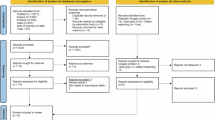Abstract
Data sources
Medline and manual searches were made of the bibliographies of all full-text articles and related reviews selected from the electronic search and the following journals: American Journal of Dentistry, Australian Dental Journal, British Journal of Oral and Maxillofacial Surgery, Clinical Implant Dentistry and Related Research, Clinical Oral Implants Research, Deutsche Zahnärztliche Zeitschrift, European Journal of Oral Sciences, International Dental Journal, International Journal of Oral and Maxillofacial Implants, International Journal of Periodontics and Restorative Dentistry, International Journal of Prosthodontics, Journal de Parodontologie, Journal of Clinical Periodontology, Journal of Dental Research, Journal of Oral Implantology, Journal of Oral Rehabilitation, Journal of Periodontology, Journal of Prosthetic Dentistry, Quintessence International, Swedish Dental Journal and Schweizerische Monatsschrift Zahnmedizin.
Study selection
Prospective or retrospective cohort studies were included if they had a mean follow-up of 5 years or more; were reported in the dental literature in the English or German language; patients had been examined clinically at the follow-up visit; and details of the characteristics of the suprastructures were reported. Publications that combined findings for both implant-supported fixed partial dentures and single-tooth crowns were selected if they allowed for extraction of the data for the single-tooth crowns group. Publications based on patient records only or on questionnaires or interviews were excluded.
Data extraction and synthesis
Failure and complication rates are calculated by dividing the number of events (failures or complications; the numerator) by the total exposure time [single crown (SC) time and/ or implant time; the denominator]. Event rates for SC and/ or implants were calculated by dividing the total number of events by the total SC or implant exposure time in years. The total number of events was considered to be Poisson distributed. To assess heterogeneity of the study-specific event rates, the Spearman goodness-of fit statistics and associated probability value were calculated. Multivariable Poisson regression was used to investigate formally whether event rates varied by crown material (metal–ceramic vs all-ceramic) or crown design (cemented vs screw-retained).
Results
Twenty-six studies were included in the meta-analysis. Survival of implants supporting SC was 96.8% [95% confidence interval (CI), 95.9–97.6%] after 5 years. The survival rate of SC supported by implants was 94.5% (95% CI, 92.5–95.9%) after 5 years of function. The survival rate of metal–ceramic crowns, 95.4% (95% CI, 93.6–96.7%), was significantly higher (P 0.005) than the survival rate (91.2%; 95% CI, 86.8–94.2%), of all-ceramic crowns. Peri-implantitis and soft tissue complications occurred adjacent to 9.7% of the SC and 6.3% of the implants had bone loss exceeding 2 mm over the 5-year observation period. The cumulative incidence of implant fractures after 5 years was 0.14%. After 5 years, the cumulative incidence of screw or abutment loosening was 12.7%, and was 0.35% for screw or abutment fracture. For suprastructure-related complications, the cumulative incidence of ceramic or veneer fractures was 4.5%.
Conclusions
An observation period of 5 years allows the conclusion that high survival rates of implants and implant-supported SC can be expected, but biological and, particularly, technical complications are frequent.
Similar content being viewed by others
Log in or create a free account to read this content
Gain free access to this article, as well as selected content from this journal and more on nature.com
or
References
Egger M, Davey Smith G, Schneider M . Systematic reviews of observational studies. In Systematic Reviews in Health Care. Meta-analysis in Context. Edited by Egger M, Davey Smith G, Altman DG. London: BMJ Books; 2003: 211–214.
Juni P, Altman DG, Egger M . Assessing the quality of randomised controlled trials In Systematic Reviews in Health Care. Meta-analysis in Context. Edited by Egger M, Davey Smith G, Altman DG. London: BMJ Books; 2003: 87–104.
Scurria MS, Bader JD, Shugars DA . Meta-analysis of fixed partial denture survival: prostheses and abutments. J Prosthet Dent 1998; 79:459–464.
Creugers NHJ, Kayser, AF, Van't Hot MA . A meta-analysis of durability data on conventional fixed bridges. Community Dent Oral Epidemiol 1994; 22:448–452.
Lindh T, Gunne J, Tillberg A, Molin M . A meta-analysis of implants in partial edentulism. Clin Oral Implant Res 1998; 9:80–90.
Attard NJ, Zarb GA . Implant prosthodontic management of partially edentulous patients missing posterior teeth: the Toronto experience. J Prosthet Dent 2003; 89:352–359.
Author information
Authors and Affiliations
Additional information
AAddress for correspondence: Dr Ronald E Jung, Department of Fixed and Removable Prosthodontics and Dental Material Science, Dental School, University of Zurich, Plattenstrasse 11, CH-8032 Zurich, Switzerland. E-mail: jung@zzmk.unizh.ch
Jung RE, Pjetursson BE, Glauser R, Zembic A, Zwahlen M, Lang NP. A systematic review of the 5-year survival and complication rates of implant-supported single crowns. Clin Oral Implant Res 2008; 19:188–195
Rights and permissions
About this article
Cite this article
Abt, E. Growing body of evidence on survival rates of implant-supported fixed prostheses. Evid Based Dent 9, 51–52 (2008). https://doi.org/10.1038/sj.ebd.6400584
Published:
Issue date:
DOI: https://doi.org/10.1038/sj.ebd.6400584



